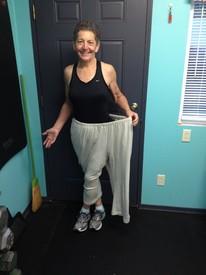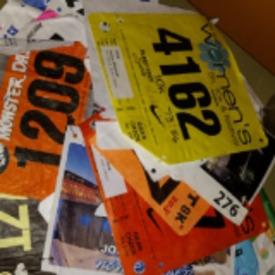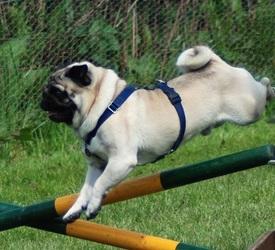Need alternative to Crunches

cherylseptember
Posts: 5 Member
After back surgery my neurosurgeon told me to never do crunches again. What are the best ab workouts that don’t involve crunches?
1
Replies
-
Crunches are actually one of the worst ab workouts, so no loss there. What about planks? Those are more effective, and they tend to cause less stress on your back. Still make sure to speak with your doctor before beginning any routine.7
-
Planks
Scissors
Bicycles
Flutter Kicks
Mountain Climbers (my least fav exercise of all time!)
Seated Russian Twist
Twisting Wood Chop with a dumbbell or medicine ball
Bird dog
...basically there’s lots of them! But double check with your doctor before doing any of them.
3 -
cherylseptember wrote: »After back surgery my neurosurgeon told me to never do crunches again. What are the best ab workouts that don’t involve crunches?
Crunches and situps are probably the worst "ab" exercises you could possibly do.
Flutter kicks
leg lifts
hanging leg lifts
ab roller
planks
Lots of options.2 -
cwolfman13 wrote: »
Crunches and situps are probably the worst "ab” exercises you could possibly do.
I’m sure this is completely true, which is very likely why he told me never to do them again. I’m a child of the 80s and there was never a workout that didn’t involve crunches, so I’m trying to reset my thinking where ab workouts are concerned.
0 -
I can’t do crunches either. You can google “standing ab exercises” to get some good alternatives.1
-
1
-
Theoldguy1 wrote: »
LOL. report back. I have challenges with my shoulders so I don't a bunch of these done, but seeing some improvement.
I'll try to remember to! I think I might try to do them without balls (so essentially just moving around in an arch in a high plank position) tomorrow at home as I figure that will be test as to whether or not I can do the movement on a solid platform as it were. That said, I'm all about fun but challenging core workouts.1 -
Place "an exercises" in the YouTube search engine and I am sure you will find something you can do. Do make sure that you check with your Doc. Before you start though.1
-
I've seen the 'Get back up' video before.. but I forget about it. Great idea for home sitting around1
-
I suggest the FitOn app. Free workout app and there is a ton of different ab videos1
-
Balance and stability exercises. Place an emphasis on enhancing core strength. You have stated that you have had a back injury so I imagine that flexion and extension is an issue? What about anti rotation exercises like the Pallof Press. There are multiple regressions and progressions but I would not just simply want to give you an exercise without knowing why your neurosurgeon told you to avoid.2
-
fitnessboxermfp wrote: »Balance and stability exercises. Place an emphasis on enhancing core strength. You have stated that you have had a back injury so I imagine that flexion and extension is an issue? What about anti rotation exercises like the Pallof Press. There are multiple regressions and progressions but I would not just simply want to give you an exercise without knowing why your neurosurgeon told you to avoid.
He told me to avoid anything that bends my body like a crunch does. It rules out a lot of yoga and Pilates unfortunately. Yoga was really helpful to me prior to my surgery. He did not say anything about rotating the trunk, so I feel like that would be fine.0 -
That effectively rules out a majority of exercises. The main contraction you are looking for then is called isometric. This is basically a static muscle contraction. I would ask about rotation exercises to be safe if they can feature full rotation or only isometric. What you can do for instance is load a band at chest height. Walk out and hold it to resist the band. Another for instance can be using a foam pad (Balance pad etc) and setting out cones to your side. Bend the knee away from the cones to engage the muscles and then extend your leg to touch the cones.
Some ideas to build base.1 -
Paloff press should be good. One thing I do is adopt a straight arm plank position but with hands on the bar of a Smith machine so there is some elevation. Set the height as you see fit. Brace the whole body and then tap the opposite shoulder with one hand while keeping everything else motionless. The first couple of reps feel way, way too easy but by the time I get to 10 I can really feel my core working.1
-
SnifterPug wrote: »Paloff press should be good. One thing I do is adopt a straight arm plank position but with hands on the bar of a Smith machine so there is some elevation. Set the height as you see fit. Brace the whole body and then tap the opposite shoulder with one hand while keeping everything else motionless. The first couple of reps feel way, way too easy but by the time I get to 10 I can really feel my core working.
For all of the criticism, the Smith Machine is a great tool for modifying resistance levels for exercises like push ups and planks.
4 -
cherylseptember wrote: »cwolfman13 wrote: »
Crunches and situps are probably the worst "ab” exercises you could possibly do.
I’m sure this is completely true, which is very likely why he told me never to do them again. I’m a child of the 80s and there was never a workout that didn’t involve crunches, so I’m trying to reset my thinking where ab workouts are concerned.
Remember Abs of Steel? I did that video religiously in the 90s LOL
I did that video religiously in the 90s LOL
I don't work abs specifically. I just make sure my core is tight while I do my lifting and that has worked wonders. I have very strong abs.1 -
I hired one of the trainers at my gym to help me develop a weight workout plan. I have back issues, and he gave me an alternative to crunches that does engage my core. I'll try to explain it; ask your doctor before starting.
Lie on your back, and lift both legs so that your thighs are perpendicular to the floor, knees bent so your calves are parallel to the floor. Engage the small of your back into the floor, and pay attention to that. Then SLOWLY lower one leg until your heel touches the floor, then SLOWLY raise it back to the original position, then do the same with the other leg. Repeat to the number of reps that is your goal, and do a couple more sets. I also do plank.
My back issues have not required surgery. I don't know whether or not this exercise would be appropriate for you. It works for me.
Anyone have a name for this exercise?0 -
For your core (and other things), the best "exercises" are squats and deadlifts.
Strict form pushups (or planks) are good too. As far as "accessory" exercises, hanging straight or knee leg lifts are best.
Have done any situps or crunches (back for your lower back and too limited in range to actually benefit your core) for over 6 yrs since I learned what works best
2 -
Theoldguy1 wrote: »
LOL. report back. I have challenges with my shoulders so I don't a bunch of these done, but seeing some improvement.
Hard, very hard. Hard enough that it's embarrassing to try in front of people. I think part of the issue is that the finger that in injured in Sept was acting up, but also it's just hard. I was able to do two balls fairly close to each other, so that's a win given that I'd never done something like that before.0 -
I second the hanging knee raises if you can do it. Ultimate burn in the ab muscles.0
-
Google Heidi Powell vacuum twists. They are so effective and shockingly easy! If your doctor says its ok (obviously).
0 -
I hired one of the trainers at my gym to help me develop a weight workout plan. I have back issues, and he gave me an alternative to crunches that does engage my core. I'll try to explain it; ask your doctor before starting.
Lie on your back, and lift both legs so that your thighs are perpendicular to the floor, knees bent so your calves are parallel to the floor. Engage the small of your back into the floor, and pay attention to that. Then SLOWLY lower one leg until your heel touches the floor, then SLOWLY raise it back to the original position, then do the same with the other leg. Repeat to the number of reps that is your goal, and do a couple more sets. I also do plank.
My back issues have not required surgery. I don't know whether or not this exercise would be appropriate for you. It works for me.
Anyone have a name for this exercise?
It’s one of the various forms of a dead bug. Another version is to lower the opposite arm at the same time you lower the leg. You can hold weights in the arms for more challenge.
Dead bugs are a great exercise to learn to engage the core and maintain a pelvic tilt during movement. Maintaining that tilt is a key, however. If you don’t remain engaged the entire movement, then you are just flopping around.
One small recommendation—most instructions I have read do not recommend touching the floor with the foot. That provides a mini “rest break” and you really want to maintain tension. Mostly, however, the more you lower the leg, the harder it is to maintain your pelvic tilt (that’s how the exercise is designed). Some people will lose form if they lower the leg too far.
Using “touching the floor” as an endpoint makes that the target for everyone, which is not the goal of the exercise. The goal is to lower the leg as much as possible *while maintaining the pelvic tilt”. For some, that might mean down to 1/2 inch off the floor, for others 12 inches.
But, in general, I think dead bugs are a key foundational exercise for doing any core work.
4 -
Thanks for those details; makes sense. More to work on for sure. I'll pay attention to weather I touch my heel or not. It's definitely doing SOMETHING, so I am not doing it COMPLETELY wrong. The closest name I could think of is Crunch with Heel Touch. But... no touch now. I've heard of Dead Bug, but I thought that was on hands and knees.0
-
@azdak: "dead bugs" is a great exercise description, I think.
So: what's so bad about crunches? I've been doing them for years without problems. I was taught (by some abs video in the 90s) to keep my back flat on the floor (no space) and do a wide variety of them, some where you elevate your legs, some where you elevate your head, some where elevate both (e.g., "dead bugs"). I never felt that any of these were very hard on the back.
More difficult is a straight leg lift, which I worked up to a minute at one point. I also do side leg lifts (which are more of a "C" done at about a 45 degree angle). These are harder on the back and need to be worked up to slowly. (And are probably not good if you have back issues.)
I was also taught to do front and side planks. I find both to be pretty hard on the back and hard in general. I also found side planks to be hard on my shoulder and stopped doing them at one point, favoring other oblique exercises.
For me, December and January are good times to think about indoor exercises, including core. I'm ready to learn some new tricks!0 -
Thanks for those details; makes sense. More to work on for sure. I'll pay attention to weather I touch my heel or not. It's definitely doing SOMETHING, so I am not doing it COMPLETELY wrong. The closest name I could think of is Crunch with Heel Touch. But... no touch now. I've heard of Dead Bug, but I thought that was on hands and knees.
That’s a bird dog.1 -
Thanks for those details; makes sense. More to work on for sure. I'll pay attention to weather I touch my heel or not. It's definitely doing SOMETHING, so I am not doing it COMPLETELY wrong. The closest name I could think of is Crunch with Heel Touch. But... no touch now. I've heard of Dead Bug, but I thought that was on hands and knees.
If you are able to maintain your pelvic tilt and not arch the lower back, then you cannot do the exercise “wrong” since that IS the exercise. Not touching the floor just makes it a little more challenging.
Dead bug is one of those exercises where you have to consciously look for ways to make it more challenging as you progress or else you can outgrow it pretty quickly. There are plenty of you tube videos for new variations.2 -
Jthanmyfitnesspal wrote: »@azdak: "dead bugs" is a great exercise description, I think.
So: what's so bad about crunches? I've been doing them for years without problems. I was taught (by some abs video in the 90s) to keep my back flat on the floor (no space) and do a wide variety of them, some where you elevate your legs, some where you elevate your head, some where elevate both (e.g., "dead bugs"). I never felt that any of these were very hard on the back.
More difficult is a straight leg lift, which I worked up to a minute at one point. I also do side leg lifts (which are more of a "C" done at about a 45 degree angle). These are harder on the back and need to be worked up to slowly. (And are probably not good if you have back issues.)
I was also taught to do front and side planks. I find both to be pretty hard on the back and hard in general. I also found side planks to be hard on my shoulder and stopped doing them at one point, favoring other oblique exercises.
For me, December and January are good times to think about indoor exercises, including core. I'm ready to learn some new tricks!
"I've been doing them and have no problems" is not a good criterion for exercise recommendations for the general population.
If someone said "exercise x" has a 70% injury rate, you probably would think that's a pretty bad exercise. Yet 1 out of 3 people could do it with no problem.
In evaluating crunches, or any other exercise, I use these factors:
1. Is it an effective exercise--does it do what you think it is doing?
2. Is it a safe exercise--can the average person do it without an increased risk of injury?
3. Is it an "approachable" exercise--meaning can the average person of low to moderate fitness do it?
4. Is it an exercise that most people perform with good form with little to no coaching?
The "core" consists of everything from the neck down to the hips. The core functions to counteract forces--flexion, extension, rotary, and lateral flexion--keep the trunk stable during movements and transferring force efficiently from the lower body to the upper body (and vice versa).
So how do crunches stack up?
1. Poor--crunches are not that effective at training the core, especially the way they are performed by 75% of the population. Training the abdominal muscles to "pull" harder serves no useful purpose. It is an isolation exercise that has little carryover. An untrained person can get some benefit if they do crunches properly, but only as practice in how to perform a pelvic tilt. Unfortunately, most people have a conventional image in their minds and little control over their abdominal muscles, so they instantly start yanking the back of their heads to "pull" the shoulders forward.
2. I think sometimes the "risks" of doing crunches is overstated--most of the injury issues from doing crunches come from improper form (although that leads to the number 4, which is how many people CAN learn good form). For people with back issues--herniated disks, past spinal surgery, etc--flexing the lumbar spine is not a good idea. Since many adults suffer from various back problems, it's not a horrible idea to discourage people from doing crunches--esp since it's such a mediocre exercise to begin with.
3. In a modified way, a crunch can be a very approachable exercise, so it can have some benefit for untrained people. It is certainly easier for a beginner than a plank. There are modified exercises called "ab curl ups" that are suitable for beginners.
4. Again, crunches rate "poor" in this category. For the most part, the only people I see doing crunches properly have enough athletic ability that they should be doing more advanced exercises anyway. Crunches and high rows are the two exercises with the worst form displayed by 75% of gym users.
So you have an exercise that is difficult for most people to master, has a moderate injury risk for both the cervical and lumbar spine, that more than 75% of the time is done improperly and, even if performed properly, does a mediocre job of training the muscles it is supposed to train.
That is "what's so bad".
5 -
Theres certainly nothing 'wrong' with crunches, which are very beneficial when done correctly.
The purpose of your ab muscles is to flex the spine. Yes, it stabilizes while performing other exercises (meaning it opposes extension of the spine). Just like the serratus 'aids' a bench press.
Keep in mind that any exercise performed incorrectly can be unfruitful or even dangerous, but that's no reason not to perform them. Correctly.
Crunches are not leg lifts. Not neck flexors. If your getting work o. The neck or hip flexors, you arent going it right.
0 -
jeffjeff85 wrote: »Theres certainly nothing 'wrong' with crunches, which are very beneficial when done correctly.
The purpose of your ab muscles is to flex the spine. Yes, it stabilizes while performing other exercises (meaning it opposes extension of the spine). Just like the serratus 'aids' a bench press.
Keep in mind that any exercise performed incorrectly can be unfruitful or even dangerous, but that's no reason not to perform them. Correctly.
Crunches are not leg lifts. Not neck flexors. If your getting work o. The neck or hip flexors, you arent going it right.
I’m not sure where you stand in the whole “facts vs opinions” debate, but the preeminent expert in back biomechanics would disagree with you.
https://www.macleans.ca/society/health/the-man-who-wants-to-kill-crunches/
And this article is from 2010. The evidence has grown quite a bit more since then.2 -
Don't rule out swimming or a deep water cardio class. Both require incredible core strength. For the deep water class, you wear a flotation belt. The idea is to perform the exercises while keeping "ears over shoulders over hips" the entire time. No sticking your butt out, no tipping forward. It's actually quite challenging.
For specific land exercises, I'd talk to a PT (physical therapist) to find out what you can safely do.3
This discussion has been closed.
Categories
- All Categories
- 1.4M Health, Wellness and Goals
- 398.2K Introduce Yourself
- 44.7K Getting Started
- 261K Health and Weight Loss
- 176.4K Food and Nutrition
- 47.7K Recipes
- 233K Fitness and Exercise
- 462 Sleep, Mindfulness and Overall Wellness
- 6.5K Goal: Maintaining Weight
- 8.7K Goal: Gaining Weight and Body Building
- 153.5K Motivation and Support
- 8.4K Challenges
- 1.4K Debate Club
- 96.5K Chit-Chat
- 2.6K Fun and Games
- 4.8K MyFitnessPal Information
- 13 News and Announcements
- 21 MyFitnessPal Academy
- 1.6K Feature Suggestions and Ideas
- 3.2K MyFitnessPal Tech Support Questions





 https://youtu.be/qjZuoKtI3Xc
https://youtu.be/qjZuoKtI3Xc











